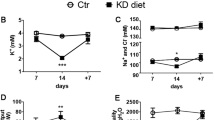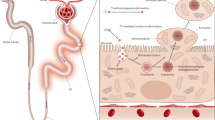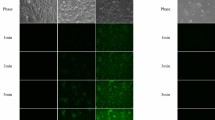Abstract
IN the kidneys of various species, the collecting tubules are composed of two types of cells. These were apparently first seen by Heidenhain1, and described in subsequent years as light and dark (intercalated) cells2. The name given to these cells alludes to the fact that the cytoplasm of the dark cells stains with various commonly used dyes more intensely than that of the light cells. The dark (or intercalated) cells reveal also strong metachromasia3. Electron micrographs show that the dense cytoplasm of the dark cells contains more RNA granules than the cytoplasm of the light cells. Mitochondria are more numerous in the dark cells and are localized not only in the basal but also in the apical portion of the cytoplasm4. In contrast, electron-dense granules are more numerous in the light cells than in the dark cells. These granules are composed of phospholipids and proteins and contain one or several crystals with a hexagonal or square lattice5.
This is a preview of subscription content, access via your institution
Access options
Subscribe to this journal
Receive 51 print issues and online access
$199.00 per year
only $3.90 per issue
Buy this article
- Purchase on Springer Link
- Instant access to full article PDF
Prices may be subject to local taxes which are calculated during checkout
Similar content being viewed by others
References
Heidenhain, R., Arch. mikros. Anat., 10, 1 (1874).
von Moellendorf (ed.), Handbuch der mikroskopischen Anatomie des Menschen, 7, 103 (Springer, Berlin, 1930).
Oliver, J., Harvey Lectures, Ser. 40, 102 (1944–45).
Rhodin, J., Amer. J. Med., 24, 661 (1958).
Miller, F., J. Biophys. and Biochem. Cytol., 9, 157 (1961).
Wachstein, M., and Meisel, E., Amer. J. Pathol., 35, 1189 (1959).
Wachstein, M., Bradshaw, M., and Ortiz, J., J. Histochem. and Cytochem., 10, 65 (1962).
Wachstein, M., and Meisel, E., Amer. J. Clin. Path., 27, 1 (1957).
Padykula, H. A., and Herman, E., J. Histochem. and Cytochem., 3, 170 (1955).
Oliver, J., MacDowell, M., Welt, L. G., Holiday, M. A., Hollander, jun., W., Winters, R. W., Williams, T. F., and Seyar, W. E., J. Exp. Path., 106, 353 (1957).
Author information
Authors and Affiliations
Rights and permissions
About this article
Cite this article
WACHSTEIN, M., BRADSHAW, M. Histochemical Adenosine Triphosphatase Activity in Dark and Light Cells of Collecting Tubules in the Mammalian Kidney. Nature 194, 299–300 (1962). https://doi.org/10.1038/194299a0
Issue Date:
DOI: https://doi.org/10.1038/194299a0
This article is cited by
-
�ber die Entwicklung und Chemodifferenzierung der Rattenniere unter besonderer Ber�cksichtigung der Geschlechtsunterschiede
Histochemie (1969)
-
�ber die Adenosintriphosphataseaktivit�t der menschlichen Haut
Archiv f�r Klinische und Experimentelle Dermatologie (1964)
Comments
By submitting a comment you agree to abide by our Terms and Community Guidelines. If you find something abusive or that does not comply with our terms or guidelines please flag it as inappropriate.



